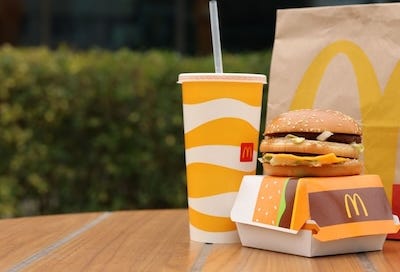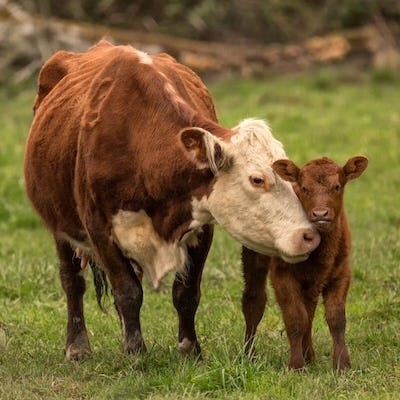It’s grilling time in the US, something Americans hold near and dear to their hearts. For many, flipping burgers isn’t just good food, it’s a way of life.
It’s also created one of the most popular, most successful restaurants in history. It would be hard-pressed to find someone who hasn’t experienced the golden arches, tasted one of their famous burgers, or inhaled a few of their fries.
I stumbled onto a meme for McDonald’s that I can’t get out of my head. It was a list of ingredients in the Big Mac, the poor quality, chemical-ridden ingredients highlighted in red. The bun has high fructose corn syrup, soybean oil, calcium propionate, and a long list of other potentially harmful chemicals. The secret sauce has high fructose corn syrup, sodium benzoate, calcium chloride, and more.
American cheese has cheese cultures, natural flavors and colors (chemicals), and soy lecithin for slice separation. With so many additives, it’s illegal to call it cheese in many countries.
Pickles seem easy - cucumbers, water, vinegar, and salt are all that’s necessary. McDonald’s adds a whole lot more, including alum, potassium sorbate, and polysorbate 80.
Oh, but then there’s the main ingredient. Just one word makes it seem like the best part of the sandwich: 100 percent pure beef.
Wait a minute, what exactly is 100 percent pure beef?
Beef consumption is fairly stable, hovering between 55 to 60 pounds per capita. Americans alone devour 50 billion burgers each year, which works out to 154 burgers per year per person, or 3 per week.
But it’s pure beef. One ingredient. Or so they make it seem.
Let’s back up to the pickle. It starts with one ingredient: a cucumber. Then it’s sliced and diced and mixed in with a whole bunch of other ingredients (10 to be exact) - many of them harmful - to get to the final product that winds up on your sandwich.
The burger goes through the same transformation. You can’t go out to a field and pick a burger. Not stating the bigger picture isn’t releasing all of the data. It’s important to realize that a lot of processing happens before you get to the 100 percent pure beef patty.
So let’s go there.
The life of a cow …
The average beef cattle has a natural life between 15 to 20 years. Yet thanks to an increased demand for beef and technology advancements, we can now typically move a cow from calf to kitchen in 14 to 20 months.
The average cow spends its life in a series of pens, transitioning to a daily diet of corn, alfalfa, hormones, and antibiotics. These change based on age and how close they are to slaughter.
The FDA approves both natural and steroid hormone drugs for beef cattle, and includes natural and synthetic estrogen, progesterone, and testosterone. The goal is fast growth. The faster they grow, the faster to market.
Worldwide, it’s estimated that 66 percent of all antibiotics used are in farm animals. For more than six decades, antibiotics have been a part of the regimen to keep cows and other farm animals healthy and to boost their growth. They are given to healthy animals, not when they fall sick. The thinking is to stave off diseases in conditions that are often 'disease-inducing’. Yet we’re consistently finding problems with this approach, including an increase in antibiotic resistance crisis in humans.
A quick search will tell you that all the BIG players in Big Ag and Big Food find zero/few problems with growth hormones and raising beef. Yet it appears here and there.
The WHO has stated that “Scientific evidence demonstrates that overuse of antibiotics in animals can contribute to the emergence of antibiotic resistance.”
The CDC warns that “3 out of every 4 new or emerging infectious diseases in people come from animals. These include viruses, bacteria, fungi, and parasites, and infect millions of Americans every year.”
Is it there is nothing to find, or they aren’t looking?
Factory farms, a fact of life …
McDonald’s states 100 percent pure beef goes into every burger. It’s also 100 percent factory farmed. Almost all - 99 percent - of animals used for food live on massive industrial factory farms, where they are crammed into cages, crates, pens, or extremely restrictive enclosures. The USDA states that 70 percent of US cows live in factory farms, where 1,000 or more beef cattle are confined together.
They may start out grazing outdoors as calves, but around six months old, they are brought into the stockyards to be fattened before slaughter. There they are fed a mixture of corn, alfalfa, hormones, and antibiotics for the rest of their lives.
Then they are crowded onto trucks, endure a stressful journey, are poked and prodded as they move along. It’s brutal at best.
Hamburger is NOT 100 percent anything …
A steak may be a cut of beef. Hamburger is not. It’s a mixture of various parts, coming from a variety of cows. Tests have found as little as 2 percent meat; the rest is blood vessels, nerves, fat, cartilage, bone, even plant material.
Then it’s mixed with a variety of things to keep it “fresh” or “give it color.” Sodium nitrite is a coloring agent that also helps keep meat from spoiling. Sulfites help maintain color and increase shelf life. Carbon monoxide binds with the meat pigment to keep it looking red and fresh. Pesticides from the corn ingested by the animals.
Grass-fed is not the solution. It’s as ambiguous as words like “natural” or “free-range.” Beef producers can obtain a “grass-fed” label simply by filing an affidavit with the USDA, defining their own claims by submitting written protocols on their grass-feeding program.
Yes, there is a difference. Grain-finished cattle are slaughtered between 120 to 240 days at around 1,350 pounds. Grass-finished cattle take longer and are slaughtered between 150 to 400 days weighing 1,150 pounds. Grain-finished cattle are fed corn and grain feed, while grass-finished cattle use pasture grasses, legumes, and post-harvest crop residue. Grass-fed is more expensive because it takes longer to move to market, and there’s less product.
What’s presented to you depends on manufacturing. Hamburger still can have fillers and chemicals. It still needs things to help it maintain its color, and prevent it from spoiling.
It starts with awareness …
I recently read that McDonald's healthier items are being axed from the menu. No more McPlant burgers. No more salads.
No surprise. McDonald’s eaters aren’t going there for healthy food. They’re going for cost and taste (addiction).
I realize there isn’t an easy solution to this. We’ve created this system over multiple decades, and it’s going to take multiple decades more to undo it. But I have a few ideas that would help us move forward quicker than the path we’re on now.
Stop subsidizing the wrong things. The US federal government spends $38 billion every year subsidizing the meat and dairy industries. Research from 2015 showed that a Big Mac would triple in price without subsidies.
Educate more people about the disasters we now call factory farms. Considering most of the meat supply comes from them, at the very least people should be aware of where their food comes from. Spell it out - and let consumers decide what kind of world they truly want to live in.
Start teaching kids how to cook. I had to take a semester of home economics in school, where I learned cooking and sewing skills several decades ago. That wasn't enough. But it’s even worse now. It’s not a required class, though some might have access to cooking as an elective. Why? Everyone can benefit from a food, cooking, and nutrition class. It’s the one skill each of us needs from birth to death. The more you know, the more educated your choices become.
Change your burger. With so many delicious options, you can still have your “burger” and enjoy what you’re eating. Give my plant-based black bean burger a try. It’s my favorite, my go-to burger whenever I want a burger for dinner.
This system didn’t start overnight. While today’s Big Food and Big Ag gurus will tell you they are maximizing food production to feed a growing world, they have never cared about maximizing health. Big Pharma ensures that’s not the case.
That’s up to us.
Maybe it’s time for us to take a step in another direction.
p.s. Did you like this message? It would mean a lot to me if you’d press the ❤️ below if you liked it, left a comment 💬, or shared it with a friend. I’m trying to grow this publication, and I depend on people like you to do so!
And if you’re new here, Welcome! 💐 I’d love to start sharing my message with you if you’re interested in all things plant-powered, proaging, or finding kitchen joy. Subscribe … and then explore my entire archive! Glad to share with you! 🙋🏼♀️











